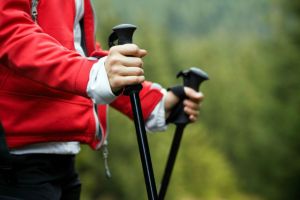
If you’re looking for a fun, total body workout that you can do in any season, look no further than Nordic Walking. This exercise was created in the 1930s in Finland, as a summer training program for cross-country skiers. Celebrated for years in northern Europe, it has recently been gaining popularity in the West due to its many health benefits.
Nordic Walking consists of walking with two poles (designed specifically for this activity), one in each hand, and using the poles to propel yourself forward. This engages the upper body, and mirrors the workout provided by cross-country skiing, which has long been known for its ability to increase strength, endurance and cardiovascular function.
According to Lucy Wyndham-Read, a personal trainer and author, “it mimics cross-country skiing, which is the toughest, most calorie-burning exercise there is and gives you the fullest range of movement of any sport. The poles encourage you to take longer strides. A bigger movement means bigger results.”
The following are just five of the many benefits that Nordic Walking offers:
Provides a great cardiovascular workout
Like regular walking, Nordic Walking is great for your heart. Since Nordic Walking activates more of your body, however, it can provide even more of a workout, and some research has found that it burns more calories.
Nordic Walking can be either leisurely or intensive, and you can easily work yourself up to the next level with practice. Some research has found that walking with arm activation can also increase energy expenditure, heart rate and oxygen uptake compared to walking without the use of the arms.
Regular cardiovascular exercise can help reduce your risk of heart disease and stroke, as well as many other chronic ailments. It can also keep you looking and feeling your best. Nordic Walking is a great way to build endurance, and can be a great part of a weight loss plan, as well.
Improves balance and coordination
The movements that Nordic Walking require can improve both balance and coordination. To properly move the poles along with your stride requires moving your arms in opposition with your legs.
When your upper and lower halves, and opposing muscle groups, must work together in this way, your entire body achieves greater balance. The more you practice, the better you can complete these motions at greater speeds.
When you walk with the use of poles, it creates better balance and stability than walking without them. This can give us – especially those of us who are not so coordinated on our feet – the confidence to relax and look around as we walk. It can also improve visual coordination, as well as posture, which suffers when we look down at the ground too often.
Engages numerous muscle groups
Nordic Walking has been found to engage up to 90 percent of the muscles in the body. Muscle groups that are especially targeted are those of the abdomen, hips, thighs, buttocks and triceps. It may also help to increase all-over mobility, and reduce muscle pain. Some research has found that neck and shoulder pain was diminished after participants underwent this activity.
On top of that, regular Nordic Walking can improve your muscular endurance, so that you can perform other exercises – and daily activities – with greater ease.
Reduces strain on the joints
Because the poles used for Nordic Walking pick up some of the weight of each step, they take some pressure off of the knees and other joints. This makes Nordic Walking an ideal exercise for older individuals, people with knee problems and those recovering from heart-related complications. It can be done at a gentle pace, so as to provide a great workout with minimum strain.
Helps those with balance problems have a safer stroll
For elderly individuals and those with equilibrium issues, walking with poles to balance them may greatly decrease the risk of a fall or similar incident. Additionally, the fact that Nordic Walking works the upper body as well is important for keeping bones and muscles strong.
How do I get started?
Upon deciding to give Nordic Walking a try, experts strongly recommend taking a class to learn proper technique. Once you’ve gotten the hang of it, you can easily branch out on your own, however, starting out without knowing the motions can do more harm than good, and can actually lead to strain or even injury.
 Look around for a class in your area – some places may even let you take your first lesson for free, so that you can ascertain whether or not you like it.
Look around for a class in your area – some places may even let you take your first lesson for free, so that you can ascertain whether or not you like it.
Before you begin, you will need to obtain a set of Nordic Walking poles. Investing in a good set of poles is essential, since poorly-made ones may vibrate and lack proper stability. They should have a high-quality set of tips to match the type of terrain that you will be walking on. Never substitute ski poles or other types of walking poles for Nordic Walking poles; they are not made for this purpose.
Talking to a customer service representative at your local sporting goods store is a good place to get your questions answered, as well as to get recommendations on the best poles. You can also purchase these online once you know what you are looking for.
The only other things you will need are a comfortable, well-fitting, lightweight pair of walking shoes and a willingness to learn, and you’ll be ready to trek!
-The Alternative Daily
Sources:
http://www.nordicwalkingusa.com
http://www.humankinetics.com/excerpts/excerpts/benefits-of-nordic-walking-
http://www.dailymail.co.uk/health/article-1249000/Nordic-Walking-shapely-arms-pert-derriere-dont-need-snow.htm

